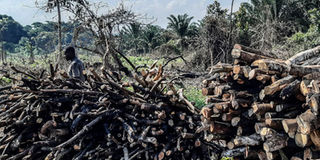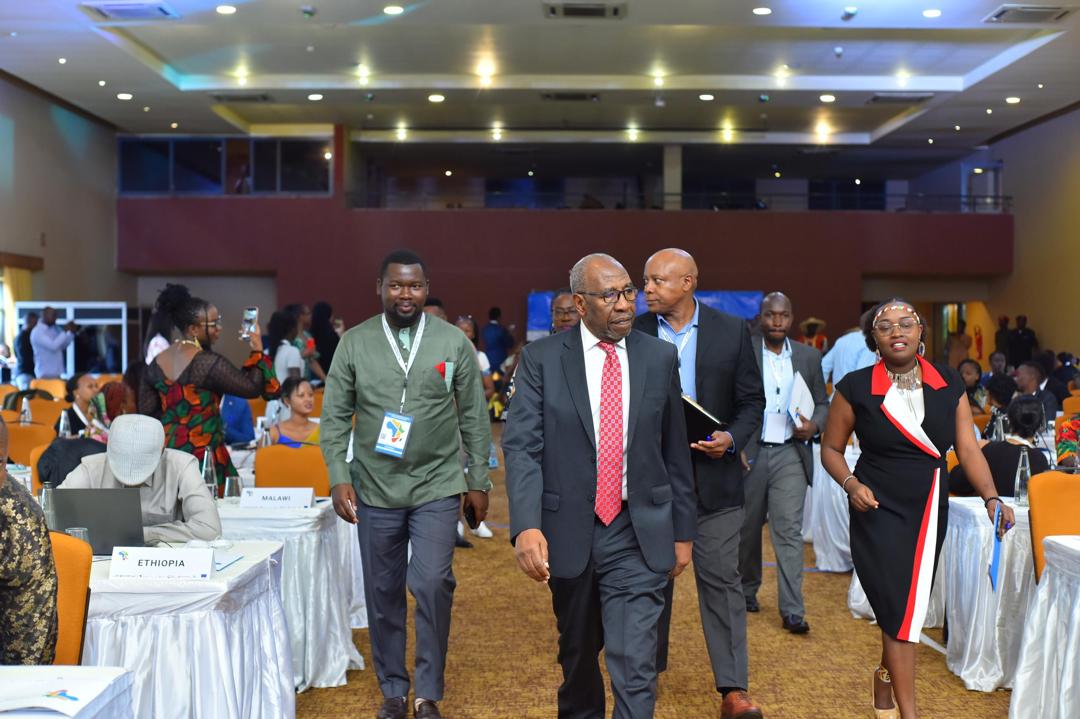Prime
Kalangala loses 2,000 acres of forests in 2 years

Deforestation. A man assembles firewood in Funve Central Reserve in Mazinga Sub-county, Kalangala District, on March 6. PHOTO BY SYLVESTER SSEMUGENYI
What you need to know:
- In 2006, the Solicitor General backed the degazettement of about 3,000 hectares of natural forests in Kalangala District.
Daniel Kaliisa, 45, is a charcoal burner and a resident of Mawaala Landing Site, Mazinga Sub-county in Kalangala District.
He switched to charcoal burning business three years ago after abandoning fishing.
“I resorted to charcoal burning in 2017 after losing all my fishing gear to soldiers deployed on the lake. They claimed my nets and boat were not of the recommended size, I was left with nothing yet I have a family to look after,” Kaliisa narrates
Well aware of the dangers paused by the indiscriminate tree cutting to burn charcoal, this is Kaliisa’s only source of livelihood.
“I know that cutting down trees is dangerous, but it is the only job I can do to survive here, I have no option,” he says.
A latest survey shows that the district has lost 2,080 acres of forest cover in the past two years. Kalangala’s acreage is 2.2 million.
According to the environmental survey conducted in December 2019 by Kalangala District NGO Forum (Kadingo), a community based organisation, indiscriminate felling of trees is mostly done in central forest reserves where 1,580 acres have been destroyed in the last couple of years.
Some of the most depleted central forest reserves, according to the survey, include Funve in Mazinga Sub-county, Bunyama, Buswa and Kisujju in Bujumba Sub-county.
Others are Buuga, Tonde, Kitemu , Bugana, Ssekazinga and Butulume.
Mr Emmanuel Ssekimpi, the chairperson of Kadingo, says private forests that have been cleared and the owners have resorted to burning charcoal, growing pineapple and rice as well as creating space for human settlement and dairy framing.
“It is worrying that Kalangala as a district is left with only six privately-owned natural forests, which are still intact. These forests sit on about 2,600 acres. The rest of the forests have since been cleared for oil palm growing,” he says.
According to the survey, majority of the depleted forests are in the villages of Mulabana, Bwendero, Bujumba and Dajje- Bweza, all located in Bujumba Sub-county. Those still intact are in the villages of Bugoma, and Bumangi in Mugoye Sub-county, and Kaazi -Malanga and Kitooke in Bujumba Sub-county.
The uncontrolled felling of trees targets old tree species and most of such activities are done at night, according to the survey.
The most felled tree species are Elgon Olive, Mvule, Musizi and Mahogany, which make high value furniture.
“Between 2015 and 2017, there was limited encroachment on both private and public forests in the district, but the situation worsened in 2018 when residents started engaging in a series of environmental degradation activities,” Mr Ssekimpi reveals.
Contradiction
The survey comes at a time when Kalangala District leaders are pushing through a proposal to have Parliament degazette Lutoboka Forest Reserve.
Mr Willy Lugoloobi, the district chairperson, says cutting down Lutoboka Forest Reserve is the only way they can expand and develop the town. The district boss argues that the town lacks land for expansion of the district prison, a mortuary and public cemetery.
Kalangala has a total of 31 central forest reserves, with 19 located on remote islands, which National Forestry Authority (NFA) officials say makes it difficult to monitor them.
Mr Phillipson Mugumya, the NFA sector manager for Buggala Islands, admits that some central forest reserves are encroached on but blames it on government failure to facilitate his team well.
NFA speaks out
“Illegal loggers enter Kalangala every day yet we are thin on the ground, on top of that; we operate on a small budget,” Mr Mugumya says
He says it is very difficult to monitor central forest reserves, especially those in distant islands such as Bukasa, Funve and Bunyama, due to transport challenges.
Mr Lugoloobi says the current deforestation is hard to control since it partly occurs in privately owned forests.
“Since residents have found rice and pineapple growing more lucrative, Many have embarked on clearing their private forests to pave way for such activities. It is a big challenge but we are going to continue sensitising residents on the dangers of deforestation,” he says.
On charcoal burning, Mr Lugoloobi says they have tried to regulate charcoal burners but their efforts are been frustrated by some NFA officials who connive with the suspects.
“Although there guidelines regulating commercial charcoal production, very few charcoal dealers few adhere to them because they have backing of some NFA staff,” he says.
Last year, Kalangala authorities issued tight guidelines to regulate charcoal trade as a remedy to save the remaining forests.
Under the guidelines, charcoal dealers are required to get licences for production and transportation of charcoal. A licence costs Shs36,000 and is renewable every month. The guidelines also stipulate that a team from the district department of natural resources has to first inspect kilns where charcoal burning is to take place and sanction trees to be harvested.
A report done by Ssese Islands Nature Conservation and Tourism Association in December 2017 showed that 60 per cent of Kalangala’ s forest cover had been destroyed between 2014 and 2016 for timber, charcoal and rice growing.
Looking back at lost forest cover
Large chunks of forests have in the past been cut down in Kalangala to pave way for commercial agriculture. In early 2002, the district lost about 20,000 acres of central reserves to oil palm growing.
Buggala Island, which is the largest of the 84 islands in Kalangala, covers 29,000 hectares, of which 10,000 have already been allocated for oil palm trees.
Recently, environmentalists warned that the continued destruction of forests on the islands will precipitate an ecological disaster which is irreversible.
In 2006, the Solicitor General backed the degazettement of about 3,000 hectares of natural forests in Kalangala District. The clearance gave way for degazettement of forest reserves in Mugoye, Banga and Towa to Bidco Oil Company to grow oil palm.
Some forecasts gloomily predict that private land in Uganda will not have forests in the next 10 years. This is backed by evidence from a 2016 Joint Water and Environment Sector Review Report that revealed that Uganda’s forest cover had reduced from 24 per cent in 1990 to just 11 per cent in 2015. Uganda’s Vision 20140 targets restoration of the country’s forest cover from 15 per cent in 2010 to 24 per cent by 2040.
STAKEHOLDERS SAY
Phillipson Mugumya, the NFA sector manager for Buggala Islands.
“Illegal loggers enter Kalangala every day yet we are thin on the ground, on top of that; we operate on a small budget.”
Willy Lugoloobi, the district chairperson
“Since residents have found rice and pineapple growing more lucrative, Many have embarked on clearing their private forests to pave way for such activities. It is a big challenge but we are going to continue sensitising residents on the dangers of deforestation.”




